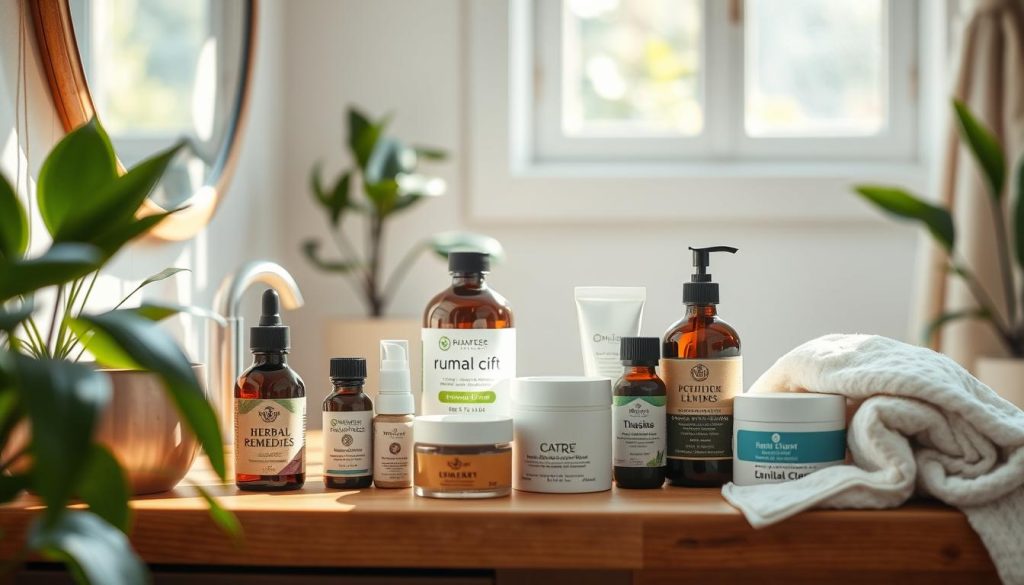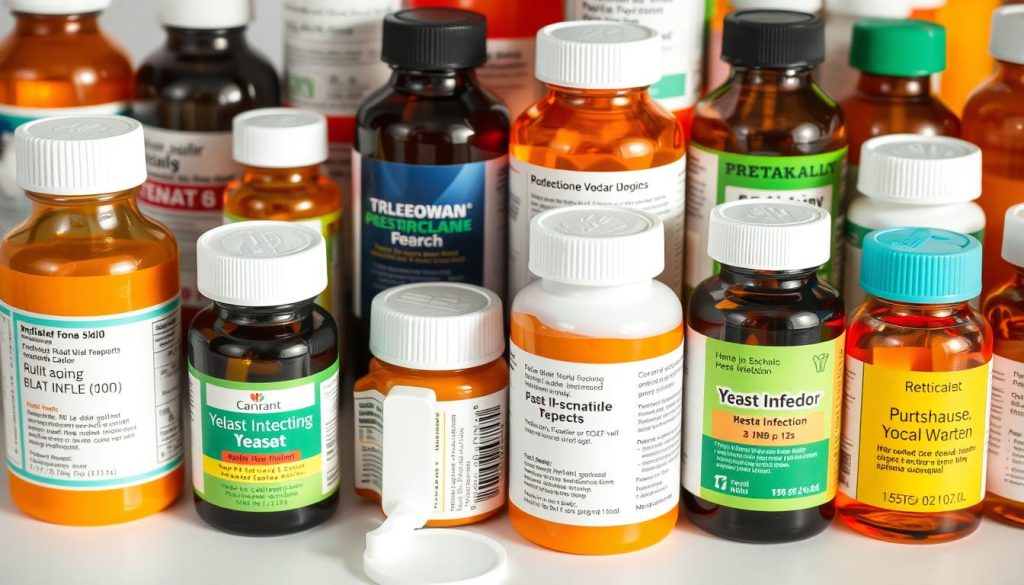When discomfort strikes, the urgent question arises: how to get rid of a yeast infection? This common culprit behind itching, irritation, and discomfort has solutions that might surprise you. But fear not, remedies are at hand, and relief is closer than one might think. In this article, we weave together empathetic understanding with professional guidance, ensuring that you’re not alone in this unpleasant journey. Let’s explore effective yeast infection treatments and how simple, accessible strategies can provide the fast relief for yeast infections you’re seeking.

- Understanding the nature and symptoms of yeast infections is the first step toward effective treatment.
- Simple hygiene practices can provide immediate comfort and aid in recovery.
- Over-the-counter medications and natural remedies can work hand in hand for faster relief.
- Dietary adjustments and probiotics play a pivotal role in preventing future infections.
- Knowing when to seek medical help is crucial for those with recurrent or severe infections.
Understanding Yeast Infections
Women’s health is very important, and knowing about yeast infections is key. These infections can be really uncomfortable and affect both body and mind. It’s vital to understand the symptoms of yeast infection, the yeast infection causes, and how Candida overgrowth works to manage and prevent them.
Identifying the Symptoms of Yeast Infection
Yeast infection signs can range from mild to severe. They often include itching, redness, and unusual discharge. If you notice these symptoms, it’s important to seek help to ease the discomfort and stop it from coming back.
Common Yeast Infection Causes
Many things can lead to yeast infections. Hormonal changes, antibiotics, and a weak immune system are big causes. These factors upset the balance of bacteria and yeast in the vagina, causing Candida to grow too much.
The Science Behind Yeast Overgrowth
To understand Candida overgrowth, we need to know about the body’s microbial balance. When this balance is off, Candida, a fungus, can grow too much. This overgrowth happens because of diet, health issues, or medicines that mess with the natural balance.
| Cause | Effect on Candida Growth |
|---|---|
| Antibiotics | Decrease in beneficial bacteria, leading to overgrowth |
| Hormonal Changes | Increases glycogen, fostering yeast growth |
| Weakened Immunity | Poor defense against microbial imbalance |

By tackling these causes and knowing how they affect Candida, we can manage and prevent yeast infections better. This leads to better health and well-being overall.
Initial Steps for Quick Relief
When you get a yeast infection, acting fast is key. This part talks about important steps to make symptoms better and stop them from getting worse. Knowing when to get help and keeping good hygiene can really help you feel better faster.
When to Consult a Healthcare Provider
It’s important to know when to see a doctor for immediate yeast infection treatment. Going early can stop the infection from getting worse. You should see a doctor if:
- You have severe symptoms like a lot of redness, swelling, or itching that won’t stop.
- After trying over-the-counter treatments, your symptoms get worse or don’t go away.
- This is your first time with yeast infection symptoms.
- You get yeast infections a lot, more than four times a year.

Cleaning and Hygiene Practices
Good hygiene is key in fighting yeast infections and helps with how to get rid of a yeast infection. Here are some tips for keeping your vagina healthy:
- Don’t use harsh soaps or cleansers in your vagina. Use mild, unscented ones instead.
- Wear loose, breathable clothes and cotton underwear. This helps keep the area dry and prevents moisture buildup, which yeast likes.
- Don’t douche. It can mess up the natural balance of bacteria in your vagina.
- Change out of wet swimsuits and exercise clothes right away.
Following these tips can help lessen symptoms and speed up recovery. But, don’t forget to also get medical advice for the best treatment.
Over-the-Counter Solutions
Many people look for quick relief from yeast infection discomfort. That’s why they turn to over-the-counter (OTC) treatments. We’ll look at the best yeast infection medication you can buy without a doctor’s note. We’ll also talk about how to use antifungal creams right and what to think about when picking OTC treatments. This ensures they are safe and work well.
Best Yeast Infection Medication
Effective OTC treatments for yeast infections help with symptoms and prevent them from coming back. Miconazole, clotrimazole, and tioconazole are top picks. These antifungal agents are key in antifungal creams and suppositories, making them essential for yeast infection treatment.
How to Use Antifungal Creams Properly
Using antifungal creams right is key for the best results. Follow the package instructions carefully. Apply the cream both inside and outside the affected area for full coverage. Remember to wash your hands before and after to prevent spreading the infection.
Considerations When Choosing OTC Treatments
Choosing the right OTC treatments for yeast infections means knowing your symptoms and any allergies. Here are some things to think about:
- Active Ingredients: Look for products with active antifungal ingredients like miconazole or clotrimazole.
- Form: Creams, ointments, or suppositories. The choice depends on personal comfort and symptom severity.
- Brand Reputation: Opt for brands with positive reviews and reliable effectiveness.
- Symptom Relief: Some products offer additional ingredients for symptom relief, such as itchiness and irritation.
If you have recurring infections or severe symptoms, talk to a healthcare provider before using OTC treatments.

Natural Remedies for Yeast Infection
Many people look for gentle ways to treat yeast infections. They turn to home remedies for yeast infection. These natural methods can help without harsh drugs. Here are some traditional and effective solutions, along with their benefits.
- Plain Yogurt: Known for its probiotics, yogurt is often touted as one of the most effective natural remedies for yeast infection. Applying unsweetened, plain yogurt to the affected area helps balance yeast levels due to its active cultures.
- Garlic: Revered for its anti-fungal properties, garlic can be used both as a dietary supplement and topically to combat yeast infections.
- Coconut Oil: This oil has caprylic acid known for its antifungal capabilities. It can be applied directly, creating a hostile environment for yeast growth.
- Apple Cider Vinegar: Diluted in warm bathwater, apple cider vinegar is believed to restore the vaginal pH balance, thus mitigating yeast proliferation.
- Tea Tree Oil: A few drops of tea tree oil, mixed with a carrier oil, can be applied to the area. It’s essential to be cautious with the concentration to avoid skin irritation.
These home remedies for yeast infection are popular but need careful use. Here’s a table comparing their use and safety considerations.
| Natural Remedy | Application Method | Key Considerations |
|---|---|---|
| Plain Yogurt | Topical application | Ensure it’s unsweetened and contains live cultures |
| Garlic | Dietary consumption or topically as paste | Might cause irritation; patch test first |
| Coconut Oil | Direct application | Pure, unrefined oil is preferred |
| Apple Cider Vinegar | Bath soaks | Always dilute to prevent discomfort |
| Tea Tree Oil | Mix with carrier oil for application | Never use undiluted; potential allergen |
Choosing natural remedies for yeast infection might help. But, it’s important to watch how your body reacts. Always check with a healthcare provider before starting any new treatments. These options work for some but not everyone. You might need to try a few to see what works best for you.

Prescription Medications for Lasting Results
When over-the-counter (OTC) remedies don’t work, prescription medications for yeast infection are key. They are made for more serious or ongoing infections. These antifungal drugs are stronger and more targeted.
Difference Between OTC and Prescription Treatments
OTC treatments are usually the first choice for yeast infections. They are easy to find and use right away. But for infections that won’t go away, prescription medications for yeast infection are better. They are stronger and match the type of yeast causing the problem.
Understanding Prescription Antifungal Drugs
Prescription antifungal drugs fight yeast infections by killing fungal cells. This makes symptoms go away faster and more completely than OTC treatments. They come in different forms like pills, creams, and suppositories, based on where and how bad the infection is.
- Oral antifungals are used for tough cases or when creams don’t work.
- Topical prescriptions are good for sensitive areas because they don’t absorb much into the body.
Following the treatment plan is very important for antifungal drugs to work. It helps kill all yeast cells and lowers the chance of the infection coming back. It also makes sure the infection is treated correctly.

Lifestyle Adjustments to Prevent Yeast Infections
Making certain lifestyle and dietary changes can help prevent yeast infections. This section will cover practical steps and food tips for daily life.
Dietary Changes for Yeast Infection Prevention
Your diet is key in fighting yeast infections. Eating less sugar and refined carbs can stop yeast from growing. Adding natural yogurt and fermented foods to your meals can also keep your vaginal flora balanced.
- Limit intake of processed sugars and carbs.
- Incorporate probiotics for vaginal health into your diet through yogurt and fermented foods.
- Stay hydrated to help flush out toxins that may contribute to infections.
The Role of Probiotics in Maintaining Vaginal Health
Probiotics are good bacteria that keep your vaginal flora in balance. Eating foods rich in probiotics can fight off bad bacteria and fungi. This helps lower the chance of getting yeast infections.
- Consume probiotic supplements or foods like kimchi, sauerkraut, and miso.
- Opt for probiotic strains known to benefit vaginal health, such as Lactobacillus.
By making these lifestyle changes for health, you can prevent yeast infections and live a healthier life. Changing your diet and adding probiotics can keep your vaginal health in top shape.
Alternative Treatments and Their Efficiency
Looking into alternative treatments for yeast infection is key. We need to see if they really work. These options include herbal supplements and changing what we eat. Each one has its own way of fighting yeast infections without traditional medicine.
Many people choose these methods for a healthier lifestyle. We’ll look at some popular ones. We’ll see if they’re backed by science or just by word of mouth.
Probiotics are a big hit for treating yeast infections. They help keep the good and bad bacteria in balance. Studies show they can help prevent yeast infections from coming back.
| Treatment Type | Description | Reported Efficacy |
|---|---|---|
| Probiotics | Natural supplements that help balance body’s microflora | High in prevention, moderate in treatment |
| Tea Tree Oil | Natural antifungal and antibacterial oil | Moderate, mixed results |
| Garlic | Known for its natural antifungal properties | Low, mostly preventative |
Tea tree oil is also popular for treating yeast infections. It’s known for fighting off fungi and bacteria. But, it’s important to use it carefully to avoid skin problems.
Some people also eat garlic to fight yeast infections. Garlic is known for its antifungal powers. But, there’s not much scientific proof it works well for yeast infections.
These alternative treatments can be useful in fighting yeast infections. But, it’s always best to talk to a doctor before trying them. This is especially true if you have recurring infections or other health issues.
Recognizing When Symptoms Warrant Medical Attention
Yeast infections are common and usually have symptoms that are not too serious. But, some situations need medical attention for yeast infection right away to avoid bigger health problems. Knowing when your symptoms are more than just a normal infection can help keep you safe from chronic yeast infections.
Warning Signs That You Should Not Ignore
Most yeast infection symptoms are just annoying but not harmful. But, some signs are serious and should not be ignored. Severe stomach pain, fever, chills, nausea, or smelly vaginal discharge are warning signs. These could mean a serious infection or another health problem that needs quick help from a doctor.
Whether it’s your first time or you’ve had yeast infections before, these symptoms mean you should see a doctor right away.
Navigating Recurrent Yeast Infections
If you keep getting yeast infections, you need to think about getting better treatment. These repeated infections might mean there’s a bigger issue or a problem with your immune system. A doctor can help find the right treatment for you.
This might include changing your lifestyle, taking prescription medicines, or even more specific treatments.
| Symptom | Usual Treatment | Sign to Seek Medical Attention |
|---|---|---|
| Itching | Antifungal creams | Itching accompanied by bleeding |
| Discharge | OTC Antifungal | Foul-smelling or unusual color |
| Redness | Home remedies | Persistent redness with swelling |
It’s important to know these signs and how to handle chronic yeast infections or bad symptoms. If your symptoms don’t get better or get worse, don’t wait to get help. Getting medical attention for yeast infection quickly is key to staying healthy.
Conclusion
Many people want to get rid of yeast infections quickly. This article aimed to help you with effective ways to do so. We talked about medical and natural remedies, over-the-counter options, and prescription meds. We also covered lifestyle changes to stop yeast infections from coming back.
Dealing with a yeast infection is more than just treating symptoms. It’s about understanding the causes and finding the right treatment. We looked at natural remedies and medicines to show how important it is to care for yourself.
Remember, yeast infections are uncomfortable, but there are many ways to feel better. If symptoms don’t go away or keep coming back, see a doctor. Being proactive and informed helps you deal with yeast infections confidently. This way, you can move towards better health and wellness.
FAQ
Q: What are the first steps to take for quick relief from a yeast infection?
A: For quick relief, keep your area clean and wear loose, cotton underwear. Avoid scented soaps and douches. Over-the-counter creams or suppositories can also help. But, if symptoms don’t get better, see a doctor.
Q: Can certain foods prevent yeast infections?
A: No food can stop yeast infections for sure. But, eating well with fruits, veggies, lean proteins, and whole grains helps your health. Yogurt with probiotics can also keep your body’s yeast and bacteria in balance.
Q: What natural remedies can be used to treat a yeast infection?
A: Try using plain yogurt, diluted tea tree oil, or a vinegar bath. These might help some people. But, they’re not a cure-all and shouldn’t replace doctor’s advice.
Q: When should someone consult a healthcare provider for a yeast infection?
A: See a doctor if you have bad symptoms like a lot of redness, swelling, or itching. If treatments don’t work, or if you get infections often. Pregnant women or those with health issues should also get medical help.
Q: What are the best over-the-counter medications for yeast infections?
A: Look for creams, ointments, tablets, or suppositories with clotrimazole, miconazole, tioconazole, or butoconazole. Always follow the directions and finish the treatment, even if you feel better.
Q: How can I differentiate between a yeast infection and other conditions with similar symptoms?
A: A yeast infection usually has itching, redness, and thick, white discharge. But, other infections can look similar. See a doctor for a sure diagnosis, especially if you’ve never had a yeast infection before.
Q: Can taking probiotics help prevent yeast infections?
A: Yes, probiotics with Lactobacillus can keep your vagina healthy. This might stop yeast from growing too much. Eating probiotic foods or taking supplements can help your vaginal health.
Q: Are prescription medications for yeast infections better than over-the-counter treatments?
A: Prescription meds aren’t always better, but they’re stronger. They’re for serious or frequent infections that don’t get better with OTC treatments. A doctor will choose the best treatment for you.
Q: What lifestyle changes can I make to reduce the risk of yeast infections?
A: To lower your risk, keep your genital area clean and wear cotton underwear. Avoid tight clothes, manage stress, eat less sugar, and add probiotics to your diet. This helps keep your vagina healthy.
Q: What are the warning signs that a yeast infection is becoming serious?
A: Watch for severe swelling, redness, or itching that causes tears. Pain during sex or when you pee, fever, or smelly discharge are also warning signs. If you see these, get medical help right away.














